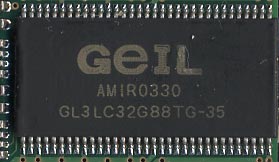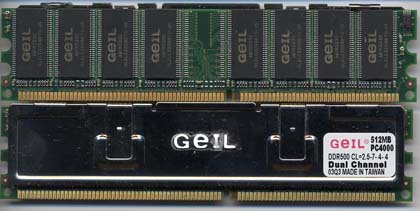Searching for the Memory Holy Grail - Part 2
by Wesley Fink on August 26, 2003 11:11 PM EST- Posted in
- Memory
Geil Platinum 4000
Click the image to view a larger picture.
Geil (pronounced Gale, as in gale-force winds) Platinum series DDR500 comes in the fanciest Dual-Channel kit packaging that we have seen. The matched pair of dual-channel modules is in a slide-top Plexiglas presentation case. Modules are packaged with the high-shine platinum-colored heatspreaders with the high-relief Geil logo. Geil uses blanks that are labeled with a Geil ID on the chips. While we do not have confirmation from Geil, the chips behave like Hynix in their timings and performance — the same chips used by OCZ and Corsair.

Geil was the biggest surprise in this roundup, performing very well at all tested speeds, and coming in at a close 2nd at DDR546 for highest stable overclock.
| Geil Platinum 4000 — 2 x 512 MB Double-Bank | |||||
| Speed | Memory Timings & Voltage | Quake3 fps |
Sandra UNBuffered | Sandra Standard Buffered | Super PI 2M places (time in sec) |
| 400DDR 800FSB |
2.5-3-4-5 2.55V |
321.53 | INT 2612 FLT 2646 |
INT 4701 FLT 4710 |
133 |
| 500DDR 1000FSB |
2.5-3-4-6 2.65V |
399.8 | INT 3336 FLT 3348 |
INT 5932 FLT 5890 |
107 |
| 546DDR 1092FSB |
3-4-4-8 2.85V |
429.13 | INT 3439 FLT 3507 |
INT 6469 FLT 6455 |
98 |











77 Comments
View All Comments
Anonymous User - Friday, August 29, 2003 - link
This is quite confusing for a noob like myself, but I want to make the right purchasing decision, as I've never dabbled in overclocking, but hope to begin with this new setup.I'm waiting for the new Abit IC7-G Max III mobo to be released shortly. I'm targeting a P4 3.0C processor, and had been looking at Geil PC4000 platinum, though I suppose I should also now consider OCZ.
What processor and RAM combination on that motherboard will provide the best total results after overclocking? What part does the timing play in it? Will a 3.0C P4 not achieve as fast a bus speed as say, a 2.8C, meaning that a 2.8 would render ultimately the highest performance?
Any help is appreciated.
Anonymous User - Friday, August 29, 2003 - link
One thing I found odd was that there was no mention of cost. I picked up 1GB of Geil PC4000 Plat for $305 shipped which is considerably less than the RAM from all the other manufacturers. Given the results, that's a pretty sweet deal.Wesley Fink - Friday, August 29, 2003 - link
#63 -Please read the review. Not everyone had DS modules available at the time. We asked manufacturers for, at the minimum, 2 double-sided modules or 4 single-sided modules. This is because it would be unfair to compare performance of 2 SS modules to 2 DS modules.
Kingston was the only manufacturer who chose to supply 4 SS modules. We compare 4SS modules to 2DS in our review which IS fair. Results with 2SS modules were used to illustrate why you should use FOUR modules for best performance if they are SS.
oldfart - Thursday, August 28, 2003 - link
Wesley, don't get me wrong. I'm not trying to say 5:4 is "better" than 1:1. Why would it be?Not too long ago there were people who were adamant that unless you ran 1:1 ratio, you had a "crippled system". Another myth that was spread around was memory timings didn't matter on a DC DDR system (where the heck did that come from?).
People sold their PC3200 and got PC3700, ran 1:1 and got no performance increase or even a performance decrease and wondered why.
Websites were doing reviews that consisted of nothing but synthetic mem benches that showed 10x - 30x the performance gain that real world benches showed. These same sites are sponsored by memory manufactures selling that ram.
I guess I just got tired of all the misinformation being put out on the net.
Truth is right now, 5:4 low latency vs. 1:1 high latency produces ~ the same results. The actual difference is nothing you would ever notice in real usage. 1% one way or the other means nothing.
Once you can have high speed and low latency, things will change.
Anonymous User - Thursday, August 28, 2003 - link
Why are they benching 256MB Kingston modules against 512MB double-sided modules from all the other vendors? The tests clearly show 4 DS configuration is fastest. Why didn't they test 512MB Kingston DS modules? They are comparing apples to oranges at Kingston's expense.Wesley Fink - Thursday, August 28, 2003 - link
It seems that those proposing 5:4 is just as good or better always want to compare the WORST DDR500 timings to the BEST DDR400 timings. 2-2-2-5 is no more a typical DDR400 timing setup than 3-4-4-8 is at DDR500. Look at the timings that actually WORKED with DDR500. In fact, IF you can find DDR400 that can do 2-2-2-5 you will pay quite a premium for it - just like you do for DDR500.Also the DDR550 we achieved with the best DDR500 would need to be compared to 5:4 at DDR440 running at 2-2-2-6 or so, and the 300FSB some achieve with the 2.4C would need DDR480 - just to run 5:4. With a CPU that achieves high FSB, the DDR500 may be the best choice EVEN at 5:4.
I do think it is a mistake to overlook how very good 5:4 can perform with FAST timings memory, but I also think it is a mistake to pretend 1:1 doesn't matter in performance - because it does. It is ONE of the things that matters, but by no means the only thing.
I am looking right now at some DDR533 Engineering Samples that run 2.5-2-3-6 at DDR533. When these and other faster timing DDR500+ are released, this argument will disappear. BOTH speed and timings matter - and neither is the complete picture.
This review goes into great detail to point out that DDR500 is NOT needed by everyone, and in fact requires a setup that can actually RUN at 250 (1000 FSB) to get ANY benefit. We also pointed out that for most with a 2.8 to 3.2 CPU that a slower memory with faster timings would be a much better choice for performance.
oldfart - Thursday, August 28, 2003 - link
I didn't compare all the results, but looked at the Q3 numbers compared to other reviews that have done the same testing. I'll use the Corsair 4000 numbers:Your review
XMS4000 DDR500 1:1 400.2 FPS
PC 3500 DDR400 5:4 393.7 FPS
This test:
http://www.hardtecs4u.com/reviews/2003/ddr400_roun...
XMS4000 DDR500 1:1 3-4-4-8 340.8 FPS
XMS3200 DDR400 5:4 2-3-2-6 338.9 FPS
Numbers are very close. 2-2-2-5 would have been faster if run that way.
***********************
This test:
http://www.ocprices.com/index.php?action=reviews&a...
XMS4000 DDR500 1:1 3-8-4-4 320 FPS
XMS4000 DDR500 1:1 2.5-7-4-4 338 FPS
XMS3200 DDR400 5:4 2-5-2-2 340.5 FPS
In this test, the PC3200 low latency is a bit faster than the PC4000 with medium timings, quite a bit faster than the slowest timings.
In all of these tests, the difference is very small when it comes down to it. A tie is more accurate.
My points:
1)the people who think they are "crippling" their P4 rig by running a mem ratio are mistaken. You can get the same performance if you set it up right
2) SiSoft mem benches do not represent real world performance. They show an inaccurate view of system performance gains.
3) Certain site push PC3700/4000 too hard and neglect to show that equal performance can be had with less expensive ram.
4) I hate posting this here!! Bring back the AT articles forum!
Wesley Fink - Thursday, August 28, 2003 - link
#35, #38, #44, #49, #50, #52, #55, #57 -To answer your question, we ran 1000FSB (500) at 5:4 with Mushkin PC3500 Level II at CAS 2-2-2-5. This Mushkin is about the only memory left that can REALLY do 2-2-2-5 at DDR400, and a review will be up soon. The testbed and ALL hardware and settings were the same as this review. Results are:
Sandra UNBuffered - 2964/2959 or avg. 2962
Sandra Buffered (Standard) – 5470/5468 or avg. 5469
Quake 3 – 393.7fps
UT2003 – Flyby: 241.84
Botmatch: 87.66
SuperPI (2M places) – 105s
Write these numbers down and compare them to Page 14 (500FSB/DDR500) charts. You will see that 5:4 2-2-2-5 is very close to the performance of the poorer DDR500 in our tests, but it does NOT beat the DDR500.
We are comparing the fastest memory I have tested at DDR400, at it’s fastest 5:4 timings, to DDR500 at much poorer timings. Of course the DDR400 goes even higher than DDR500 and performs even better.
BOTH timings and FSB speed matter, and the answers are not as simple as some have stated.
vailr - Thursday, August 28, 2003 - link
Please consider adding TwinMos 3700 to your updated review.http://www.showtimecomputer.com/cpumem/ddr.asp
quote: "
512 MB PC3700 400 (DDR/CL2.5 Twinmos Chip $119.00
512 MB PC3700 400 (DDR/CL2.5 Winbond Chip $125.00
TwinMOS stays one step ahead of the technology curve by launching one of the first PC3700 Unbuffered DIMM Modules. Featuring speeds up to 466Mhz, PC3700 DDR 466 delivers enhanced bandwidth up to 3728MB per second.
Check it Out: WWW.TwinMOS .COM "
Slappy00 - Thursday, August 28, 2003 - link
Ill say one thing about OCZ, wheather or not the review is bias in any way, ocz has come a long way to prove that they have a good product and stand by it. I have read countless posts where OCZ would gladly RMA some user's memory and give them pretested memory as a replacement. I for one bought GEiL pc4200 (really pc4000 with looser timings) and wish I had the kind of support offered by OCZ.In the end I would only use results based on reviews as a guide not a reference.
For example:
I have an Abit IS7 (BIOS 16) and my board will not do anything faster than 260 1:1 (520DDR) without memory errors (via memtest86), but I can run the timings more aggreesively (2.5-8-4-4) at 260 for some reason. I cant use any dividers (5:4 3:2) and I cant use GAT or I get the dreaded long beep at boot-up.
just goes to show you that just because its printed doesn't mean it's right for you.